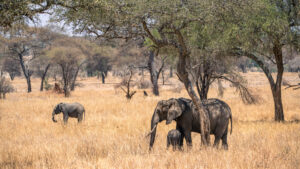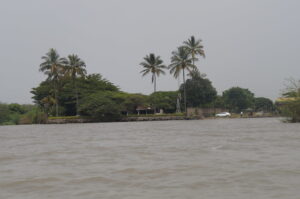9 ways to explore classic Tanzania on self drive
The country in central Africa is much more than just a safari destination. One nation that doesn’t take things lightly is Tanzania. Africa’s tallest mountain, Kilimanjaro, and its second-largest national park, Nyerere, are claimed by the huge, brave, and stunning country. It contains some of the largest and deepest lakes on the continent (Victoria and Tanganyika), as well as some of the best beaches in the world (on Zanzibar and elsewhere). It also has the world’s greatest mammal migration, with over a million wildebeest annually crossing the Serengeti, and the largest intact volcanic crater (wildlife-rich Ngorongoro). These are but a handful of the highlights; continue reading to learn about many more.

1. Marvel at blood-red Lake Natron
One might imagine what life could have been like at the very beginning of Africa by looking across Lake Natron. This bleak, weird, primordial-feeling location, which appears to have been unaltered by human hands, is protected by the puffing cone of still-active Ol Doinyo Lengai, the Maasai people’s “Mountain of God.” Furthermore, it appears to be actively antagonistic to the majority of life forms. To begin with, it is difficult to get to, requiring a dramatic and difficult journey off the northern safari circuit. However, the lake’s waters are also blood-red, very shallow, covered in ash, caustically alkaline, and frequently exceedingly hot. Some creatures, like the 2.5 million lesser flamingos that come to feed on the algae in Natron, which gives them their rose feathers, have amazingly adapted to these severe conditions. Maasai guides may lead you on treks along the bizarre lakeside and through a steep ravine to Engare Sero Falls, where you can cool yourself in the pools below.
2. Explore Ngorongoro Crater
Even without animals, the Ngorongoro Crater would be a breathtaking site. It is the largest preserved caldera in the world, 10 to 12 miles across, and was created when the volcano fell in on itself after a massive eruption around 2.5 million years ago. Reaching 2,000 feet, its rocky walls enclose broad grassy plains, a small soda lake, a forest of yellow fever trees, seasonal wetlands, and permanent springs. However, it is not lifeless. The crater, on the other hand, is home to one of the continent’s densest concentrations of large mammals, including lions, hyenas, and black rhinos, as well as wallowing hippos, enormous tuskers, and herds of zebra and wildebeest. Although the crater itself has no lodges, there are a number of lodges on the rim and in the area that provide game drives. Expect amazing animal encounters along with a plethora of different vehicles.
3. Follow the Great Migration through the Serengeti
The vast migration of millions of ungulates around one of Africa’s most magnificent ecosystems is maybe the most amazing sight. The term “iconic” is well-deserved by the Serengeti, with its expansive grassy savannah, rocky kopjes, flat-topped acacias, and plenty of wildlife. Huge numbers of zebra, gazelles, and other antelopes accompany the grunting, dust-kicking herd of up to two million wildebeest that migrates around it each year, following the seasonal grasses. In January and February, wildebeest give birth on the southern plains of the Serengeti, and in April, the herds begin to march north. The most dramatic months are June through October, when large numbers of people congregate to run across the Mara and Grumeti rivers as a variety of predators, including crocodiles, lions, leopards, and hyenas, wait in the wings.

4. Learn about Swahili culture on Zanzibar
The name “Zanzibar” stimulates the senses, including the sight of tropical beaches, the heat of the sun, and the aroma of spices. After a safari or Kili climb, the Indian Ocean archipelago is a great place for some beach relaxation, but it’s also worth seeing for its Swahili culture. With influences from Africa, the Arab world, Persia, India, and Europe, Zanzibar has been a trading hub since the ninth century. Stone Town, a UNESCO-listed maze of winding streets and coralline stone palaces and townhouses with elaborately carved doorways and balconies, is where you can see it all. Fresh seafood, foreign clothing, beaded jewelry, cinnamon, and fresh ginger may all be found in these colorful and fragrant bazaars. While traditional cuisine like sour urojo soup (made with mango, turmeric, potato, and lemon) and octopus curry offer a glimpse of Zanzibar’s cosmopolitan past, dhow cruises allude to the travels of previous traders.
5. Dive off Pemba
Offering a more unusual Indian Ocean getaway, this beautiful, undulating island is smaller, quieter, and less frequented than its well-known neighbor Zanzibar. Though tourism is still in its infancy, the area nonetheless boasts white sand beaches, swaying coconut trees, and air that smells like cloves. The major center, Chake Chake, is no match for Zanzibar’s euphoric Stone Town, but Pujni, the remains of a 13th-century Swahili settlement, is close by, and the coast is dotted with historic fishing settlements, with wooden ngalawa boats bobbling in the waves. The diving and snorkeling are excellent, especially off the west coast where fish abound in coral gardens. Turtles, manta rays, and dolphins are frequently encountered.
6. Sail around Mafia
Another step into the relaxed is Mafia, which is located 100 miles south of Zanzibar. Its marine park is Tanzania’s top dive site and safeguards an amazing expanse of the southern waters, reefs, mangroves, and islets of the archipelago. Chole Bay’s pristine shallows are ideal for novices and teeming with life; for more seasoned divers, there are colorful walls, caverns, and overhangs that are frequented by sharks, large grouper, and dolphins. Even though Mafia itself doesn’t have the nicest beaches, being castaway with a hamper full of fresh seafood and chilled beer while sailing by dhow to stunning sandbars is as close to paradise as it gets.

7. Take tea in Mufindi
Mufindi is a welcome change in Tanzania’s southern highlands. This is a land of lush hills covered in tea plantations and shrouded in mists; forget about the arid, dusty plains. It’s a fantastic area to explore on foot, by kayak, mountain bike, or horseback. Monkeys and a wide variety of birds can be heard or observed along the trails that wind through the lakes and montane forest. Mufinidi Highland Lodge, which was founded on a family farm in the 1990s, effectively opened the region to tourists and is still committed to protecting its natural woodlands. Located 6,500 feet up in the highlands, the lodge’s log cottages provide a refreshing stay.
8. Climb Mount Kilimanjaro
Climbing Africa’s highest peak, Mount Kilimanjaro, at 5,895 meters (19.341 feet), is a terrible experience. And very clever. And completely unforgettable. The actual trek isn’t technically challenging; it’s more of a steady ascent than a steep scramble. However, the breathtaking altitude poses a significant obstacle. There are seven different routes, and the majority begin above 2,000 meters (6,550 feet) above sea level in the mountain’s verdant montane rainforest zone. It takes about six days to reach the summit, which involves a significant elevation increase. Along the way, you should anticipate being amazed by the enormous lobelia and uncanny lunar-like plateaux, the porters’ strength and endurance, the companionship of other hikers, the amount of food you eat, and the emotional rush that occurs when—if—you reach the summit: relief, wonder, and joy, to put it mildly.
9. Take a ferry across Lake Victoria
The second-largest freshwater lake in the world, after North America’s Superior, fills a shallow dip between the Western and Eastern Rift Valleys. Its size is so enormous that it looks more like an inland sea than a lake. Kenya and Uganda are lapped by its northern coasts. The southern half of the lake and several of its larger islands, such as the picturesque Rubondo, now a national park, and the rocky Ukerewe, about the size of St. Lucia, are claimed by Tanzania. The main port of Lake Victoria is sprawling Mwanza, which is reachable by boat, train, and airplane. The best way to take in the lake’s size and possibly even see some of its resident birds is to board one of the ferries that travel across it. The fascinating Bujora Sukuma Museum, which provides information on the culture of Tanzania’s largest tribe, the Sukuma, is located nearby.
How to do it
How to get there:
Take a plane from Amsterdam, Dubai, or Istanbul to Dar es Salaam and Kilimanjaro, or from Doha to Zanzibar. Another choice is to take a national carrier flight via an East African hub, such Nairobi or Addis Ababa, and then make a subsequent connection.
It takes about 14 hours to get from London to Dar es Salaam via Nairobi.
How to get around:
While many upscale safari hotels are accessible by private charter aircraft, domestic airlines like Air Tanzania and Coastal Aviation offer internal flights.
Overland travel is slower and less expensive; most major safari destinations have well-maintained roads, though some are not. In big cities like Dar es Salaam or Arusha, it is feasible to rent a 4WD, although it is preferable to do so with a driver who is knowledgeable with the roads and can serve as a guide. It takes about 90 minutes to take a ferry from the mainland to Zanzibar.
When to go:
Peak season is during the warm, dry months of July through October, when average temperatures range from 25 to 27 degrees Celsius. This is the ideal time of year to go on safari, visit Zanzibar, and climb Kilimanjaro. July and August are the busiest months for the Great Migration river crossings in the northern Serengeti. The months of November through December saw the “short rains.” In addition to the arrival of migratory birds and lower costs, expect somewhat higher temperatures and brief, stinging rains. In the southern Serengeti, the wildebeest calve around January to March, which is also a great period for Kili climbs. The weather is hot and muggy (up to 30 degrees Celsius), and wildlife is scattered. From mid-March until June, there is a period of rainy weather known as the “long rains.” Since now isn’t the ideal time to see wildlife, some camps close and others reduce their rates.

